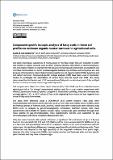Por favor, use este identificador para citar o enlazar a este item:
http://hdl.handle.net/10261/215910COMPARTIR / EXPORTAR:
 SHARE
BASE SHARE
BASE
|
|
| Visualizar otros formatos: MARC | Dublin Core | RDF | ORE | MODS | METS | DIDL | DATACITE | |

| Campo DC | Valor | Lengua/Idioma |
|---|---|---|
| dc.contributor.author | San Emeterio, Layla M. | - |
| dc.contributor.author | Bull, Ian D. | - |
| dc.contributor.author | Holtvoeth, Jens | - |
| dc.contributor.author | González-Pérez, José Antonio | - |
| dc.date.accessioned | 2020-07-03T07:30:21Z | - |
| dc.date.available | 2020-07-03T07:30:21Z | - |
| dc.date.issued | 2020-04-20 | - |
| dc.identifier | doi: 10.5194/egusphere-egu2020-18526 | - |
| dc.identifier.citation | Compound-specific isotopic analysis of fatty acids in three soil profiles to estimate organic matter turnover in agricultural soils., EGU General Assembly 2020, Online, 4–8 May 2020, EGU2020-18526, https://doi.org/10.5194/egusphere-egu2020-18526, 2020 | - |
| dc.identifier.uri | http://hdl.handle.net/10261/215910 | - |
| dc.description | 9 páginas.- Presentación nº 18526 en EGU General Assembly 2020, Online, 4–8 May 2020 | - |
| dc.description.abstract | Soil lipids encompass substances of mainly plant or microbial origin that are insoluble in water and soluble in organic solvents such as ether, hexane, benzene, chloroform or dichloromethane. This soil organic fraction is of great interest because it encompasses biomarkers associated to soil microbial communities, i.e. Gram positive/negative bacteria, mycorrhizae, actinomycetes, etc. and because of its transitory nature that provides insights into soil organic matter (SOM) dynamics and soil carbon turnover. Compound-specific isotope analysis (CSIA) have been used in biomarker studies to investigate the assimilation of carbon from external inputs into SOM. This study determined the distribution and d13C composition of fatty acids as dominant part of the soil lipid fraction to assess turnover times in agricultural practice. Soil samples were taken from three depth intervals (0-5, 5-20, 20-40 cm) from a Mediterranean agricultural soil at ¿La Hampa¿ experimental station used for a crop rotation experiment with wheat (C3 plant) and maize (C4 plant). Using the C4 biosynthetic pathway, maize discriminates less strongly against 13C, i.e. d13C values of fatty acids originating from maize are less negative than those of fatty acids from wheat. Soil lipids were extracted using a DCM:MeOH (3:1) solvent mixture. Fatty acids were transmethylated with MeOH:acetyl chloride (30:1) to form fatty acid methyl esters (FAMEs) while the hydroxy groups of hydroxy acids, alcohols, sterols and other compounds were silylated using BSTFA prior to analysis by gas-chromatography combustion chamber isotope ratio mass spectrometry (GC-C-IRMS) for carbon isotope ratios. Compounds were identified through their mass spectra by gas-chromatography mass spectrometry (GC-MS) and quantified by gas chromatography with flame ionization detection (GC-FID). Only two maize harvests after wheat cultivation, a significant 13C enrichment of up to 2 ¿ was found in the saturated C20, C22 and C23 FAMEs and the mono-unsaturated C22 FAME and of up to 5 ¿ in the leaf wax-derived C29 and C31 n-alkanes relative to the control treatments without maize input. No significant differences, however, were found for alcohols and hydroxy acids. These differences may respond to the high specificity of the long-chain n-alkanes from plant origin, whereas the other compounds FAMEs, and mainly alcohols and hydroxyl acids are less specific plant markers and may have a diverse origin. No significant differences in the isotopic composition were observed at different depths within treatments apart from a slight d13C enrichment of 1.5 ¿ in the upper soil layer (0-5 cm) in the maize plots relative to the deeper layers. It is worth noticing that SOM content remained very low (< 1.3%) over the entire duration of the experiment, with no significant differences despite the high amount of C4 biomass presumably added to the soil during the two growth periods. Together with the d13C enrichment observed in the maize plots, this points to high mineralization rates in these soils and implies both a rapid turnover of plant debris into the SOM. | - |
| dc.description.sponsorship | Ministerio de Ciencia Innovación y Universidades (MICIU) for INTERCARBON project (CGL2016-78937-R). L. San Emeterio also thanks MICIU for funding FPI research grants (BES-2017-07968). Mrs Desiré Monis is acknowledged for technical assistance. | - |
| dc.language | eng | - |
| dc.relation | info:eu-repo/grantAgreement/MINECO/Plan Estatal de Investigación Científica y Técnica y de Innovación 2013-2016/CGL2016-78937-R | - |
| dc.rights | openAccess | - |
| dc.title | Compound-specific isotopic analysis of fatty acids in three soil profiles to estimate organic matter turnover in agricultural soils. | - |
| dc.type | presentación | - |
| dc.identifier.doi | 10.5194/egusphere-egu2020-18526 | - |
| dc.relation.publisherversion | http://dx.doi.org/10.5194/egusphere-egu2020-18526 | - |
| dc.date.updated | 2020-07-03T07:30:22Z | - |
| dc.rights.license | https://creativecommons.org/licenses/by/4.0/ | - |
| dc.contributor.funder | Ministerio de Ciencia, Innovación y Universidades (España) | - |
| dc.relation.csic | Sí | - |
| item.openairetype | presentación | - |
| item.grantfulltext | open | - |
| item.cerifentitytype | Publications | - |
| item.openairecristype | http://purl.org/coar/resource_type/c_18cf | - |
| item.fulltext | With Fulltext | - |
| Aparece en las colecciones: | (IRNAS) Comunicaciones congresos | |
Ficheros en este ítem:
| Fichero | Descripción | Tamaño | Formato | |
|---|---|---|---|---|
| EGU2020-18526_presentation_Layla_San_Emeterio.pdf | 2,16 MB | Adobe PDF |  Visualizar/Abrir | |
| EGU2020-18526-print_abstract.pdf | 293,45 kB | Adobe PDF |  Visualizar/Abrir |
CORE Recommender
Page view(s)
138
checked on 22-abr-2024
Download(s)
211
checked on 22-abr-2024
Google ScholarTM
Check
Altmetric
Altmetric
Este item está licenciado bajo una Licencia Creative Commons

